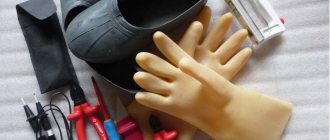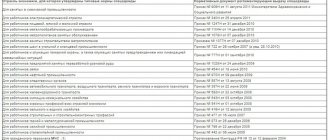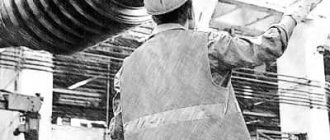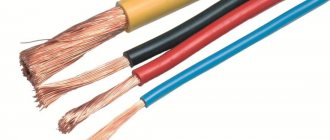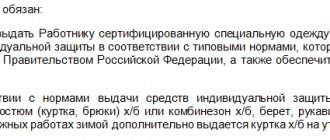All production workers must be provided with protective clothing free of charge. This includes not only a jacket and pants, but also gloves, a helmet, safety glasses, shoes, vests, etc. If the employer does not purchase CO for personnel, workers have the right to independently purchase any appropriate set of workwear, regardless of its price, and the company is obliged to compensate its cost upon presentation of the check.
However, no matter who buys the workwear, it has its own expiration date. The service life of workwear is established by standards, in accordance with the type of production and the work performed by the worker. The same standards establish the deadlines for writing off workwear.
Requirements for CO
When does the period of use of the issued workwear begin?
The shelf life of workwear according to the law depends on the specifics of the activity, climate and work performed. The standards for the terms of use of workwear for 2021 are prescribed in the corresponding order of the Ministry of Finance No. 997n. It also indicates how and from what point the service life of CO begins to be calculated, when it needs to be changed, what rules apply to different enterprises, how to determine the wear and tear of clothing and the service life of PPE (personal protective equipment).
So, according to the order of the Ministry of Finance, the time of use of the “special clothing” begins to be recorded from the moment the worker signs in the journal about receiving the CO. This rule applies to the standard form. The accounting for the winter kit, which is often used for 4-5 months a year, depending on the region, includes the time that the CO remains in the warehouse.
Documents establishing the framework for the operation of overalls
Personal protective equipment (PPE). Procedure and standards for issuing PPE, terms of wearing
In accordance with Order of the Ministry of Health No. 290 dated June 1, 2009. “On approval of intersectoral rules for providing workers with special clothing, special footwear and other personal protective equipment”, workers engaged in work with harmful and (or) dangerous conditions there, as well as in work performed in special temperature conditions or associated with pollution, are issued free of charge, in accordance with the established procedure, certification or declaration of conformity of personal protective equipment in accordance with the standards approved in the manner determined by the Government of the Russian Federation.
The purchase of PPE is carried out at the expense of the employer.
An employer may purchase PPE for temporary use under a lease agreement.
Employees engaged in work with harmful and (or) dangerous working conditions, as well as in work performed in special temperature conditions or associated with pollution, are provided with appropriate PPE free of charge.
The provision of personal protective equipment to employees, including those acquired by the employer for temporary use under a lease agreement, is carried out on the basis of the results of certification of workplaces for working conditions, carried out in the prescribed manner, and in accordance with the standard standards for the free issuance of special clothing that has undergone certification or declaration of conformity in the established manner , special footwear and other personal protective equipment (hereinafter referred to as standard standards).
The employer is obliged to ensure that employees are informed about the PPE they are entitled to. When concluding an employment contract, the employer must familiarize employees with these Rules, as well as with the standard standards for issuing PPE .
The employee is obliged to correctly use the PPE issued to him in the prescribed manner.
If an employee engaged in work with harmful and (or) dangerous working conditions, as well as with special temperature conditions or associated with pollution, is not provided with PPE in accordance with the legislation of the Russian Federation, he has the right to refuse to perform labor duties.
An employee’s refusal to perform such work does not entail bringing him to disciplinary liability.
How standards for wearing workwear depend on the type of production
Standards for issuing workwear by profession
The legislative framework provides for the issuance of protective clothing and personal protective equipment to 195 types of professions. In general, the service life of workwear, the standards of which are prescribed in Resolution of the Ministry of Labor No. 997n, depends on three factors - climatic conditions, type of production and work responsibilities of the subordinate. So, for an employee of one workshop where metal is melted, the wearing standards will be different from the norms for an employee of the next workshop where the same metal is processed.
Additional factors:
- type of pollution;
- there is a danger of electric shock;
- temperature indicators;
- presence of toxic substances;
- work associated with increased risk.
How it looks like in an example. Let's say we have a fleet driver and a battery technician. For them, the terms of use of workwear at the enterprise, the table of which is in the above-mentioned resolution, is:
- The driver, who additionally carries out car repairs in the company’s garage, is entitled to the usual cotton overalls, which are issued for up to two years, and gloves, one pair of which is required for 2 months of use;
- For a battery operator, the standards provide for the issuance of a suit with protection from acid burning for 1.5 years and 6 pairs of rubber gloves for 1 year, rubberized boots and an apron with a bib for up to 2 years, gloves made of dielectric material, glasses and galoshes “until worn out.”
An example of standards for the use of personal protective equipment by a repairman
Additional Information! The duration of wearing overalls is additionally established by a special commission during production certification.
Legislative regulation
The norms and terms of issuance are regulated by the regulations of the ministries:
- Order of the Ministry of Labor No. 997n (for workers in cross-cutting professions and hazardous production);
- by order of the Ministry of Health and Social Development No. 297 (signaling clothing);
- Resolution of the Ministry of Labor No. 70 (warm workwear);
- by order of the Ministry of Health and Social Development No. 290n (intersectoral rules).
These documents apply to all industries, but there are also separate rules for each industry. Standard industry standards for issuing workwear are largely outdated, so the equipment may be either excessive or insufficient. Another problem is that not all professions and types of work are taken into account in industry standards. In such cases, they are guided by standard standards for cross-cutting professions and intersectoral rules. They are used to select workwear that is similar in profession or type of work.
Establishment of the period: “until wear”
As already mentioned, some personal protective equipment is issued to the employee “until worn out.” This list includes a signal vest, the service life of which is unlimited, safety glasses, noise-cancelling headphones, knee and elbow pads, some types of support belts, etc. The issuance of new PPE is provided only in the event of loss, theft, breakage, obsolescence and beyond the operational time frame , installed by the manufacturer.
Sample order for standards for issuing workwear
Thus, for example, if for supporting belts GOST provides for maximum use for a period of up to 25 years, then if during this time it has not become unusable, it is in any case subject to write-off.
In addition, the employer must conduct regular inspections of personal protective equipment. The enterprise must have a log in which each inspection will be recorded.
Additional Information! Typically, for long-life PPE, inspections are carried out every six months or a year.
How to determine for accounting purposes the wear period of workwear if the issuance rate is set “until worn out”
Any wear time can be set for items of equipment, the main thing is that it does not exceed the standards for maximum use of the product by GOST or the manufacturer of the product.
For example, the useful service life of safety glasses can range from a couple of months to 20 years. Therefore, for accounting purposes, it is possible to establish a systematic write-off every year, referring to the conditions of the work performed.
Can the useful life of workwear be extended?
The useful life of workwear can be extended if it is in proper condition.
There is a form that is transferred by employees back to the employer before the expiration of the period of its use according to the standards - this happens in two cases:
- When a person leaves the company.
- When a person moves to another position within the enterprise, but receives new responsibilities, the performance of which requires a different type of workwear.
What do you do with this form? Here they do not necessarily rely on what period of wear of workwear was initially noted. The solution to the issue depends on the state of the thing. It may be written off or reused. The second option is possible with the following algorithm of actions:
- The form is taken out of service.
- A commission is formed to assess the suitability of the received protective clothing.
- The assessment itself is carried out directly, which determines the degree of wear and the possibility or impossibility of further use of the item.
- Workwear classified as “suitable for further use” is re-issued with a note in the employee’s personal card.
When issuing, special marks may be made, for example, “Degree of wear 50%”, etc. More detailed questions regarding the wear-out period of workwear can be discussed with the relevant authorities at a particular enterprise.
Want to know more on the topic? I wonder if the logo on workwear affects how long it lasts? Do you want to acquire a uniform for employees that will be of high quality and comply with standards? Then contact PRO-Print!
Depending on climate
Since the operating time of winter and summer clothing may be different, depending on the weather conditions of the region and the seasonal work performed, the time of wearing them should also be different.
Lifespan of winter workwear
The service life of the winter set depends on the climate zone to which the region belongs. That is, there are no uniform standards and those responsible for the service life of work clothes must know their climate zone in order to write off CO on time.
Climate zones were established based on data on average annual temperatures and average wind speed. According to this principle, the territory of the Russian Federation is divided into 4 belts; the manager can find out his belt in the same order of the Ministry of Labor under No. 63. Each belt has its own class of protection, which must be provided by clothing. Class 1 refers to the warmest regions, class 4 to the harshest.
The service life for each class will be as follows
There is also a special climate zone characteristic of the Arctic. There, the winter set should be changed every 1.5 years, and shoes every 2 years.
For how long are summer work clothes issued to workers by law?
There are no fixed service periods for each type of activity. The law says that the service life of summer clothing is 1 year, but the commission must further consider the issue of a possible extension of the period if there are grounds for this.
Not every production facility provides shoes for the summer period. For each industry, the period will be different, depending on the conditions and specialization of the employee. But, according to the norms, shoes cannot be worn for more than three years.
Deadlines for issuing winter and summer workwear
Seasonal kits are issued at the arrival of winter or summer, and when they end, they are put into storage until the next season. A set of summer work clothes includes a suit made of cotton or mixed fabric, boots and gloves without insulation. The timing of wearing winter workwear is determined by the region’s affiliation with one of the five zones.
| Climate zone | Regions | Norms and terms for issuing warm workwear |
| I | Astrakhan, Belgorod, Kaliningrad regions | Insulated jackets and trousers are issued for 3 years, shoes - for 4 |
| II | Voronezh, Moscow, Leningrad regions | Jackets and trousers are changed every 2.5 years, shoes - every three |
| III | Altai, Novosibirsk region, Karelia | Clothes are issued for 2 years, shoes - for 2.5 |
| IV | Kamchatka, Kuril Islands, Murmansk region | Warm workwear is provided for 1.5 years, felt boots - for 2 |
| Special | Chukotka and other polar territories | Replacement occurs as in the previous paragraph. But they additionally issue a sheepskin coat for 4 years, a hat with earflaps for 3 years, and fur mittens for 2 years. |
Thus, an insulated signal suit for a road worker in Voronezh is issued for two and a half years, and the same suit for a worker in Murmansk is issued for a year and a half.
Overalls for line personnel
Depending on the type of production, line personnel include different groups of workers, not only those who work in production. This also includes catering workers, medical organizations, cashiers, salespeople, etc.
Their standards for compliance with workwear are approximately the same. Usually this is a cotton robe or a suit of jacket and trousers.
Additional Information! In winter, line workers who perform job duties outside are required to be given felt boots, a winter jacket or a quilted jacket.
The average service life of overalls for line personnel is limited to 24 months. In some cases this period may be 18 months. If the manufacturer does not indicate an expiration date, the clothing is disposed of after 24 months.
Personal protective equipment
According to Part 3 of Art. 221 of the Labor Code of the Russian Federation, the employer is obliged to ensure the timely issuance of personal protective equipment in accordance with established standards. The protective equipment that is issued to employees must be suitable for their gender, height and size, conditions and nature of the work performed and ensure labor safety (clause 8 of the Rules). If an employer uses foreign-made PPE, then it must meet the labor protection requirements established by the legislation of the Russian Federation and have a certificate of conformity.
Upon dismissal, transfer to another job, at the end of the wearing period, upon receipt of new ones, the workwear must be returned, since it is the property of the organization. If, upon dismissal, an employee handed over workwear, the wear period of which has not expired, then the commission determines the percentage of wear and tear, and when re-issuing used work clothes, the wear period is calculated taking into account the established wear rate.
Extending the wearing period of workwear
Clause 6.17 of the standards for the service life of workwear provides for an extension of the wearing period of PPE. For this purpose, an inventory commission is assembled at the enterprise, which evaluates the further suitability of the overalls.
This practice is quite common. At some enterprises, due to the specifics of the position, workers may not wear special clothing, which needs to be changed every year, for two or three years.
At the same time, in the course of professional suitability for further wearing of clothing, a certificate is issued, which indicates all the defects existing at the time of inspection. If the flaws do not meet the standards for extending the service life of the PPE, it is written off. For example, if the percentage of engine oil stains on a mechanic’s uniform is less than 15, you can wait a while with the write-off.
How is the period of use of PPE calculated?
The employer is obliged to replace or repair personal protective equipment that has become unusable before the end of its useful life for reasons beyond the control of the employee. In the event of loss or damage to personal protective equipment in designated storage areas for reasons beyond the control of employees, the employer is obliged to provide them with other serviceable copies (clause 9 of the Rules).
The emerging contradiction has not yet been commented on by the Russian Ministry of Labor, and there are no official clarifications on this issue. In addition, according to the already mentioned Certification Rules, the validity period of the certificate of conformity for personal protective equipment is three years, and during this period personal protective equipment may be subject to repeated inspections.
Deduction of cost upon dismissal
It is important to understand that work clothes purchased for workers become the personal property of the enterprise, not the worker. Simply put, it is put on balance. Upon dismissal, the employee is obliged to return to the employer the protective clothing on the balance sheet.
Additional Information! If the dismissed employee does not do this, the employer has the right to withhold the market value of the purchased clothing from the calculated salary. But according to the labor code, the employer does not have the right to withhold more than 20% of the employee’s salary.
Organizing the storage and care of personal protective equipment. Issue norms.
Home Favorites Random article Educational New additions Feedback FAQ⇐ PreviousPage 4 of 5Next ⇒
1. Mandatory requirements for the acquisition, issuance, use, storage and care of special clothing, special footwear and other personal protective equipment are established by the Intersectoral Rules for Providing Workers with Special Clothing, Special Footwear and Other Personal Protective Equipment (hereinafter referred to as the Rules).
2. The requirements of the Rules apply to employers - legal entities and individuals, regardless of their legal forms and forms of ownership.
3. PPE refers to personal equipment used to prevent or reduce workers’ exposure to harmful and (or) hazardous production factors, as well as to protect against pollution.
4. The employer is obliged to ensure the acquisition and issuance of PPE that has been certified or declared conformity in the established manner to workers engaged in work with harmful and (or) dangerous working conditions, as well as in work performed in special temperature conditions or associated with pollution.
The purchase of PPE is carried out at the expense of the employer.
An employer may purchase PPE for temporary use under a lease agreement.
Employees engaged in work with harmful and (or) dangerous working conditions, as well as in work performed in special temperature conditions or associated with pollution, are provided with appropriate PPE free of charge.
5. The provision of personal protective equipment to employees, including those purchased by the employer for temporary use under a lease agreement, is carried out in accordance with the standard standards for the free issuance of special clothing, special shoes and other personal protective equipment (hereinafter referred to as the standard standards), which have been certified or declared in the prescribed manner compliance, and based on the results of a special assessment of working conditions.
6. The employer has the right, taking into account the opinion of the elected body of the primary trade union organization or other representative body of workers and its financial and economic situation, to establish standards for the free issuance of special clothing, special shoes and other personal protective equipment to employees, which improve the protection of employees from existing in the workplace, harmful and (or) dangerous factors, as well as special temperature conditions or pollution.
These standards are approved by local regulations of the employer based on the results of a special assessment of working conditions and taking into account the opinion of the relevant trade union or other body authorized by employees and can be included in a collective and (or) labor agreement indicating standard standards, in comparison with which the provision of workers is improved personal protective equipment.
7. The employer has the right, taking into account the opinion of the elected body of the primary trade union organization or another representative body authorized by employees, to replace one type of personal protective equipment provided for by the standard standards with a similar one that provides equivalent protection from dangerous and harmful production factors.
8. The issuance of personal protective equipment to employees, including foreign-made ones, as well as special clothing held by the employer for temporary use under a lease agreement, is permitted only if there is a certificate or declaration of conformity confirming the compliance of the issued personal protective equipment with the safety requirements established by law, as well as the availability sanitary-epidemiological report or certificate of state registration of dermatological PPE, issued in the prescribed manner.
The purchase (including under a lease agreement) of personal protective equipment that does not have a declaration of conformity and (or) a certificate of conformity or that has a declaration of conformity and (or) a certificate of conformity that has expired is not allowed.
9. The employer is obliged to ensure that employees are informed about the PPE they are entitled to. When conducting induction training, the employee must be familiar with the Rules, as well as the standard standards for issuing personal protective equipment corresponding to his profession and position, according to the “List of works and professions that give the right to receive free personal protective equipment.”
10. The employee is obliged to correctly use the PPE issued to him in the prescribed manner.
11. In case of failure to provide an employee engaged in work with harmful and (or) dangerous working conditions, as well as with special temperature conditions or associated with pollution, PPE in accordance with the legislation of the Russian Federation, he has the right to refuse to perform labor duties, and the employer does not have the right to demand that the employee fulfill them and is obliged to pay for the downtime that arises for this reason.
12. PPE issued to employees must correspond to their gender, height, size, as well as the nature and conditions of the work they perform.
13. The employer is obliged to organize proper accounting and control over the issuance of personal protective equipment to employees within the established time frame.
The period for using PPE is calculated from the date of actual issue to employees.
The issuance and handing over of PPE to employees is recorded by an entry in the personal record card for the issuance of PPE.
The employer has the right to keep records of the issuance of personal protective equipment to employees using software (information and analytical databases). The electronic form of the registration card must correspond to the established form of the personal registration card for the issuance of personal protective equipment. At the same time, in the electronic form of a personal record card for the issuance of PPE, instead of the employee’s personal signature, the number and date of the accounting document on the receipt of PPE, on which the employee’s personal signature is indicated, are indicated.
It is allowed to maintain cards for recording the issuance of personal protective equipment in electronic form with mandatory identification of the employee.
The employer has the right to organize the issuance of PPE and their replaceable elements of simple design, which do not require additional training, through automated issuance systems (vending equipment). This requires personification of the employee and automatic filling of data on issued PPE into the electronic form of the card for recording the issuance of PPE.
14. When issuing PPE to employees, the employer is guided by standard standards corresponding to its type of activity.
In the absence of professions and positions in the relevant standard standards, the employer issues to employees PPE provided for by the standard standards for workers of cross-cutting professions and positions in all sectors of the economy, and in the absence of professions and positions in these standard standards - by the standard standards for workers whose professions (positions) are typical for work performed.
15. Foremen, foremen performing the duties of foremen, assistants and helper workers, whose professions are indicated in the relevant standard standards, are issued the same PPE as employees of the corresponding professions.
16. The PPE for workers, specialists and other employees provided for in the standard standards is issued to these employees even if they are senior in their profession and position and directly perform the work that gives them the right to receive these personal protective equipment.
17. Workers who combine professions or constantly perform combined jobs, including as part of complex teams, in addition to the PPE issued to them for their main profession, are additionally issued, depending on the work performed, other types of PPE provided for by the relevant standard standards for the combined profession (combined type works) with entering a note about the issued PPE in the personal record card for the issuance of PPE.
18. Employees temporarily transferred to another job, employees and other persons undergoing vocational training (retraining) in accordance with an apprenticeship contract, pupils and students of educational institutions of primary, secondary and higher vocational education while undergoing practical training (industrial training), foremen industrial training, as well as other persons participating in the employer’s production activities or carrying out control (supervision) measures in the established field of activity in accordance with current legislation, PPE is issued in accordance with standard standards and Rules for the duration of this work (undergoing vocational training, retraining, industrial practice, industrial training) or implementation of control (supervision) measures.
Employees of third-party organizations, when performing work in production shops and areas where there are harmful and (or) hazardous production factors that can affect workers, must be provided with PPE by their employer in accordance with the standard standards provided for employees of relevant professions and positions of the organization, to which they are sent.
Managers and specialists who, in accordance with their job responsibilities, periodically visit production premises (sites) and may, therefore, be exposed to harmful and (or) hazardous production factors must be issued appropriate PPE as those on duty (during the visit to these facilities).
19. In cases where such PPE as a signal vest, a safety harness, a restraint harness (safety belt), dielectric galoshes and gloves, a dielectric mat, safety glasses and shields, filtering PPE for respiratory organs with anti-aerosol and anti-gas filters, insulating PPE for organs breathing protection, protective helmet, balaclava, mosquito net, helmet, shoulder pads, elbow pads, self-rescuers, headphones, anti-noise inserts, light filters, vibration-proof mittens or gloves, etc. are not specified in the relevant standard standards, they can be issued to employees with a wear period “until wear out” based on the results of a special assessment of working conditions, as well as taking into account the conditions and characteristics of the work performed.
The above PPE is also issued based on the results of a special assessment of working conditions for periodic use when performing certain types of work (hereinafter referred to as duty PPE). At the same time, anti-noise liners, balaclavas, as well as personal protective equipment for respiratory organs, which do not allow repeated use and are issued as “duty” ones, are issued in the form of a disposable kit before the work shift in an amount corresponding to the number of employees at a given workplace.
20. Duty PPE for general use is issued to employees only for the duration of the work for which they are intended.
The specified PPE, taking into account the requirements of personal hygiene and the individual characteristics of workers, is assigned to certain workplaces and transferred from one shift to another.
In such cases, PPE is issued under the responsibility of the heads of structural units authorized by the employer to carry out these works.
21. PPE intended for use in special temperature conditions caused by annual seasonal temperature changes are issued to employees at the beginning of the corresponding period of the year, and at its end are handed over to the employer for organized storage until the next season.
The time for using these types of PPE is set by the employer, taking into account the opinion of the elected body of the primary trade union organization or other representative body of workers and local climatic conditions.
The time period for wearing PPE used in special temperature conditions includes the time of their organized storage.
22. PPE returned by employees after the wear period has expired, but suitable for further use, is used for its intended purpose after taking measures to care for it (washing, cleaning, disinfection, degassing, decontamination, dust removal, decontamination and repair). The suitability of the specified PPE for further use, the need for and the composition of measures to care for it, as well as the percentage of wear of the PPE are established by an official authorized by the employer or the labor protection commission of the organization (if any) and are recorded in the personal record card for the issuance of PPE.
23. PPE rented is issued in accordance with standard standards. When an employee is given special clothing rented by the employer, the employee is assigned an individual set of PPE, for which the appropriate marking is applied to it. Information about the issuance of this kit is entered into the employee’s personal PPE registration and issuance card.
24. When issuing PPE, the use of which requires practical skills from workers (respirators, gas masks, self-rescuers, safety belts, mosquito nets, helmets, etc.), the employer ensures that workers are instructed on the rules for using said PPE, the simplest ways to check their functionality and serviceability, and also organizes training on their use.
25. In the event of loss or damage to personal protective equipment in the designated storage areas for reasons beyond the control of employees, the employer issues them other serviceable personal protective equipment. The employer provides replacement or repair of personal protective equipment that has become unusable before the end of the wearing period for reasons beyond the employee’s control.
26. The employer ensures that employees use PPE.
Workers are not allowed to perform work without PPE issued to them in the prescribed manner, as well as with faulty, unrepaired or contaminated PPE.
27. At the end of the working day, employees are prohibited from taking PPE outside the employer’s territory or the territory where work is carried out by the employer - an individual entrepreneur. In some cases, when, due to working conditions, the specified procedure cannot be followed (for example, during logging, geological work, etc.), PPE remains with employees during non-working hours.
28. Employees must notify the employer (or his representative) about the failure (malfunction) of PPE.
29. In accordance with the deadlines established in national standards, the employer ensures testing and checking the serviceability of PPE, as well as timely replacement of parts of PPE with reduced protective properties. After checking the serviceability of the PPE, a mark (stamp, stamp) is placed on the timing of the next test.
30. The employer, at his own expense, is obliged to provide care and storage of PPE, promptly carry out dry cleaning, washing, degassing, decontamination, disinfection, neutralization, dust removal, drying of PPE, as well as repair and replacement of PPE.
For these purposes, the employer has the right to issue employees with 2 sets of appropriate PPE with double the wearing period.
31. To store PPE issued to employees, the employer provides specially equipped premises (dressing rooms) in accordance with the requirements of building codes and regulations.
32. If the employer does not have the technical capabilities for dry cleaning, washing, repair, degassing, decontamination, neutralization and dust removal of personal protective equipment, these works are performed by an organization engaged by the employer under a civil contract.
33. Depending on working conditions, the employer (in its structural divisions) sets up dryers, chambers and installations for drying, dust removal, degassing, decontamination and neutralization of personal protective equipment.
34. Responsibility for the timely and full issuance of PPE that has been duly certified or declared conformity to employees in accordance with standard standards, for organizing control over the correct use of them by employees, as well as for the storage and care of PPE rests with the employer (his representative) .
35. State supervision and control over the employer’s compliance with these Rules is carried out by the federal executive body exercising the functions of supervision and control over compliance with labor legislation and other regulatory legal acts containing labor law norms, and its territorial bodies (state labor inspectorates in the constituent entities of the Russian Federation) .
36. Control over compliance by employers (legal entities and individuals) with the Rules in subordinate organizations is carried out in accordance with Articles 353 and 370 of the Labor Code of the Russian Federation by federal executive authorities, executive authorities of constituent entities of the Russian Federation and local governments, as well as trade unions, their associations and their technical labor inspectors and authorized (trusted) persons for labor protection.
37. The standards for issuing workwear are approved by the employer and are given in Appendix 1 to these instructions.
7. Circumstances and causes of individual typical accidents, accidents, fires that occurred at the enterprise and other similar industries due to violations of safety requirements. Prevention of industrial accidents.
June 24, 2021 A serious industrial accident occurred at JSC Agrotown Zhiryatinsky. While driving cows into a barn, a milking machine operator suffered blunt force trauma to the abdomen. The woman came across a stick.
Based on the results of the GIT inspection, the following violations of the requirements of legislative and other state regulations containing labor protection requirements were identified:
— workers engaged in work with harmful and dangerous working conditions are allowed to perform work without undergoing periodic medical examinations;
no training has been organized for blue-collar workers to provide first aid to those injured at work;
drivers, tractor drivers, general workers are not provided with personal protective equipment;
the official responsible for electrical equipment and the person replacing him during the period of absence have not been appointed.
There is no introductory training program; driver training is not carried out on road safety issues.
Other violations of the Labor legislation of the Russian Federation were also identified.
Based on the results of the inspection, the General Director of Agrogodok Zhiryatinsky OJSC was issued an order to obligatorily eliminate violations of labor legislation.
For violations of the law, the legal entity OJSC Agrogodok Zhiryatinsky was brought to administrative responsibility.
In 2013, a milkmaid from JSC Sabinovo in the Ivanovo region suffered an industrial accident while unloading silage from the back of a car; while driving along rows of animals, she fell from the back of the car onto the floor of the feed aisle. The woman received injuries in the form of a closed craniocerebral injury and closed fractures of the distal metaphysis of the right radius and the main phalanges of the 2-4 fingers of the right hand. These bodily injuries fall into the category of bodily injuries resulting in grievous bodily harm.
During the investigation into the circumstances of the accident, it was established that the woman, in violation of Article 212 of the Labor Code of the Russian Federation, did not undergo training and testing of labor protection knowledge in the prescribed manner.
The Ivanovo Interdistrict Investigative Department of the Investigative Committee of the Russian Federation for the Ivanovo Region issued a resolution to initiate a criminal case under Part 1 of Art. 143 of the Criminal Code of the Russian Federation, namely “Violation of labor protection rules”
In 2010, an employee of a Moscow company left the office building to have lunch in the office canteen in the next entrance during the hours set for lunch breaks. While crossing the patio, she stepped in a puddle and received a chemical burn to her foot as a result of contact with deicing agents. The sidewalk treated with reagents belongs to the company’s yard territory. According to clause 4.5.18 of the Rules for the sanitary maintenance of territories, organizing cleaning and ensuring cleanliness and order in Moscow, approved. by Decree of the Moscow Government dated November 9, 1999 No. 1018 (hereinafter referred to as the Rules), responsibility for the organization and performance of cleaning work and maintenance of territories (in-plant, intra-yard) of enterprises, organizations and institutions, other economic entities, the adjacent five-meter zone (from the boundaries of the plots, fences, buildings), entrances to them is entrusted to enterprises, organizations, institutions and economic entities that own, possess, lease or have on their balance sheet buildings located in these territories. This applies to all legal entities located or operating in Moscow, regardless of their form of ownership and departmental affiliation, and their officials. At the same time, each city has its own rules for improvement, cleanliness and order. Thus, a chemical burn received by an employee on the way to the service canteen during the lunch break hours established by the PVTR can be qualified as a work-related injury. The basis for this conclusion is Art. 108 and 227 of the Labor Code of the Russian Federation, as well as clause 4.5.18 of the Rules.
It's the "little" injuries that happen most in the office, and they happen where you least expect them.
Furniture with sharp edges + mountains of documents + busy work = increased risk of accidents.
In the usual office routine, we forget about the dangerous sharp corners of furniture and often leave various drawers with documents open. Therefore, to help us avoid such troubles that “encounters” with these objects entail, it is worth remembering 7 simple rules.
1. Do not place shelves at head level.
2. If possible, “round off” sharp corners and edges of furniture using special plastic attachments.
3. Don't forget to close drawers and doors.
4. Do not place heavy objects on cabinets.
5. Do not use chairs on wheels or tables as stepladders.
6. Stay calm when sorting documents.
7. Provide yourself with “transparency” of the workplace and monitor its order and cleanliness.
Typical office injuries:
- Slips and trips are two of the most common causes of office injuries. Therefore, to improve safety, it is necessary to get rid of cracks or uneven protruding edges of the floor.
- Various wires from computers, printers, phones and other office equipment must be made safe for movement in the office.
- And now a separate request for girls and women! Please continue to wear high heels if you are comfortable in them! But we kindly ask you not to read any documents while walking!
- Check escape routes again. You should never use them for storage or storage purposes! Emergency door openings must always be clear!
Dangerous office supplies such as staplers, pins, hole punchers and other “sharp” objects are found in great abundance on the desks of office workers. Therefore, be careful with these seemingly “harmless helpers.” By complying with safety requirements and avoiding unnecessary fuss, you will not join the ranks of workers who unsuccessfully attached a “tack to their finger” or “received a paper clip shot in the palm due to an uncontrolled stapler.” If you accidentally break a glass or vase, do not throw the broken pieces into the waste paper basket. It is best to place such “hazardous waste” in a designated location where it is clearly visible to cleaning personnel.
Another risk factor for office workers is the need to look at the monitor for almost all eight hours of the working day. Doctors warn that lack of rest for the eyes can lead to a significant decrease in visual acuity.
To ensure optimal performance, prevent fatigue and maintain health when working with a PC, it is necessary to observe regulated breaks during the work shift and organize a work shift by alternating work with and without a PC.
If visual discomfort and other unfavorable subjective sensations occur among those working with a PC, despite compliance with sanitary, hygienic and ergonomic requirements, it is recommended to use an individual approach with a limitation of the time spent working with a PC.
The total time spent working with PVEM within one work shift should not exceed 50% of the working time. It is recommended to organize breaks of 10 - 15 minutes every 45 - 60 minutes of working with the PVEM.
⇐ Previous4Next ⇒
How to report on the use of work clothes
Typically, the responsibility for keeping track of work clothes is assigned to a responsible employee, for example, a warehouse manager. But, according to the law, the main responsible person, who during the inspection will answer to the commission, is the immediate supervisor of production.
Reporting can be carried out both in written and electronic form, and can be presented either in a journal or in a card index.
PPE accounting scheme


